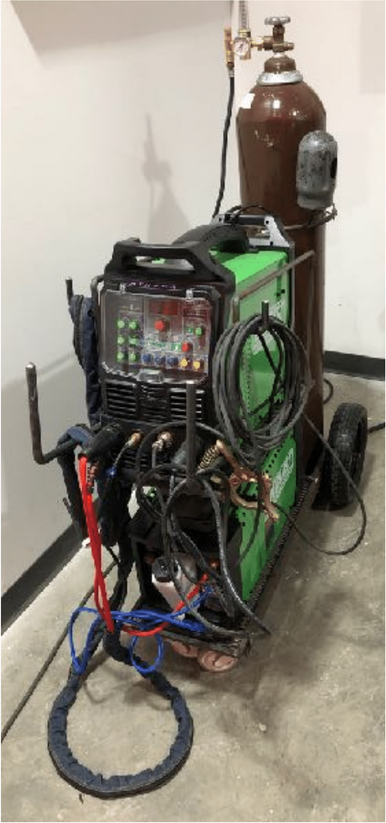Category:TIG Welders: Difference between revisions
No edit summary |
No edit summary |
||
| Line 81: | Line 81: | ||
* '''Solvent based metal cleaning should be done with Simple Green or other low-intensity cleaners.''' | * '''Solvent based metal cleaning should be done with Simple Green or other low-intensity cleaners.''' | ||
* '''No brake cleaner.''' Brake cleaner contains chlorinated hydrocarbons that | * '''No brake cleaner.''' Brake cleaner contains chlorinated hydrocarbons that creates '''phosgene''' ("Nerve gas" from WWI) when combined with UV light. ''Ventilation will not prevent poisoning.'' | ||
* Abrasive cleaning methods are also appropriate. | * Abrasive cleaning methods are also appropriate. | ||
Revision as of 22:53, 6 February 2024
| Extra precaution required for welders. Training / Tool Testing is essential. See Welding Safety doc. | |
|---|---|
| Eye protection required! | ||
|---|---|---|
| TIG Welders | |
|---|---|
| General Info | |
| Make | Various |
| Model | Various |
| Serial | Unknown |
| Specs | n/a |
| Manual | |
| Asylum Info | |
| Location | Metal Shop |
| Rubric | n/a |
| Training | [https://www.artisansasylum.com/class-
catalog Tool classes] |
| Testing | [https://www.artisansasylum.com/tool-testing Tool
testing], or come to the shop on Tool Testing Night |
| Restrictions | red |
Tools in this category are:
Everlast_Power_TIG_200DV_TIG_Welder "Artemis"
Everlast_Power_TIG_250EX_TIG_Welder "Athena"
Lincoln Electric Square Wave TIG 175 Pro
Equipment Manuals are available for these tools:
Link to: TIG 200DV Manual
Link to: 250EX Manual
Link to: Square Wave 175 Pro Manual
Link to: Synchrowave 200 Manual
Use for:
- Most metals: Steel, stainless, aluminum, titanium, etc.
- The shop provides consumables for mild steel (filler wire, 2% thoriated tungsten). Users provide consumables for other metals.
- See corresponding manufacture manual for each welder’s stick welding capabilities.
Do Not Use for:
- Galvanized, plated, painted, oiled, rusted, or powder coated metals.
Safety Hazards
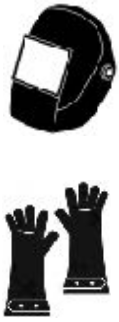
| |
|---|---|
1. UV damage to eyes. Welding Helmet with shade 10 protection or darker is required. Darker for heavier applications.
2. UV burns on exposed skin. The rays from the arc can cause severe radiation burn (worse than sunburn.) Cover exposed skin.
3. Burns from flame, sparks, hot workpieces. Wear welding gloves, cotton clothing (no synthetics) and closed toe shoes.
4. Poisoning from breathing gases produced by welding. Use ventilation. Do not stick head in fumes. Respirator recommended.
5. Keep workplace clear of flammable materials including grease, oil, solvents, paper.
6. Electrocution if welder is mishandled. Do not weld near puddles of water on floor or work area, especially when using AC output.
* Various safety links to keep you awake at night:
ANSI - General Safety in Welding and Cutting
Operation Notes
- Solvent based metal cleaning should be done with Simple Green or other low-intensity cleaners.
- No brake cleaner. Brake cleaner contains chlorinated hydrocarbons that creates phosgene ("Nerve gas" from WWI) when combined with UV light. Ventilation will not prevent poisoning.
- Abrasive cleaning methods are also appropriate.
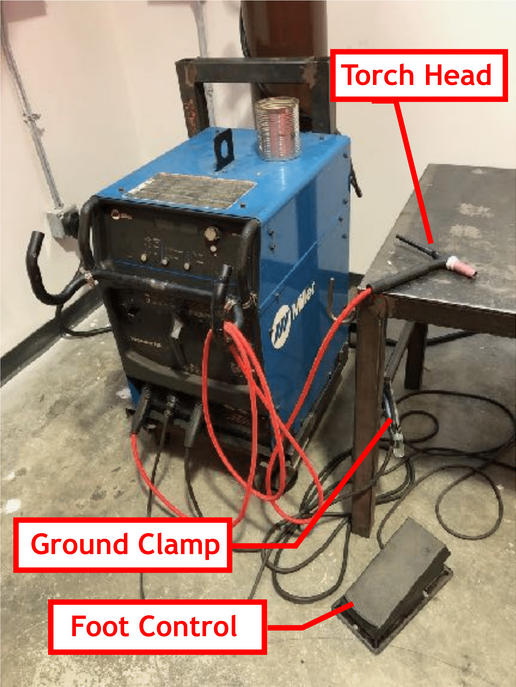
| |
|---|---|
| TIG welder in the Metal Shop |
- The Shop supplies TIG welding consumables intended for use on mild steel. Users are responsible for providing consumables for other metals.
- The Shop’s TIG welders use 100% Argon Gas.
- Beware of mild shock from the work table or the workpiece if the Ground Clamp is not attached.
Set-Up Procedure
1. Safety First
- Turn on welding bay ventilation.
- Remove flammable materials and water from welding area.
- Protect bystanders from the arc-flash, If you can’t depend on the protective vinyl flaps on the welding bays, use welding screens.
- Make sure the workpiece is clean before welding. Flammable substances such as grease and oil can ignite.
2. Attach the ground clamp to bare metal on the work table. If the workpiece is too large for the work table, clamp the workpiece.
3. Outfit your work space
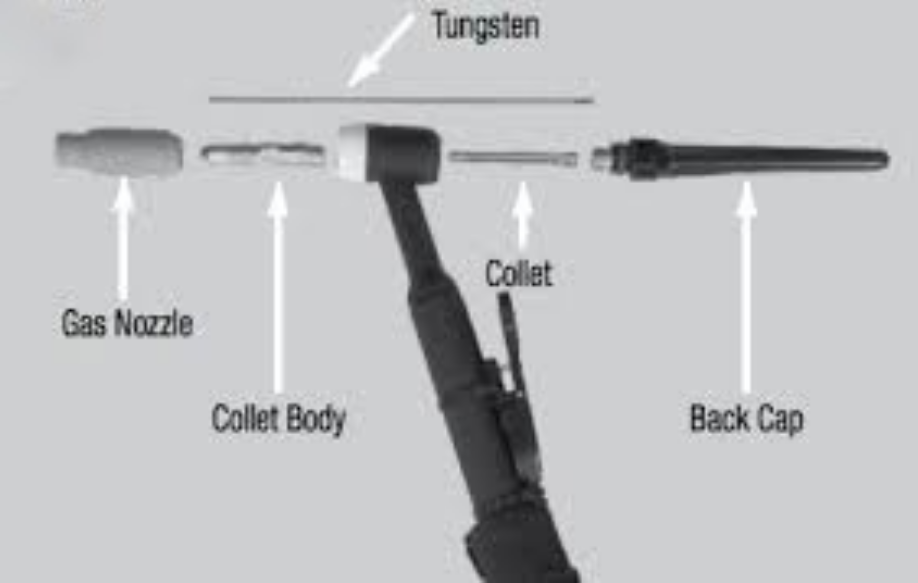
| |
|---|---|
| Exploded view of the TIG torch assembly |
- Filler wire is available in the rack on the middle toolbar, outside the two large welding bays.
- Check the torch head.
Spare torch parts are kept in the Shop’s supply cabinet.
If necessary, insert a fresh tungsten electrode. Tungstens are sharpened on a dedicated pedestal grinder. Remember to remove gloves when using the grinder.
- Assemble other accessories as needed (clamps, magnets, wood TIG blocks, receptacle for hot trash, emergency water bottle (for burn first aid).
4.Check to see if the welder has been shut down properly.
- Is the power shut off?
- Is the gas shut off at the cylinder valve?
5. Plug the machine in and turn on.
'6. Turn the gas on. If needed, adjust the pressure.
- SLOWLY crack the tank valve counterclockwise. Watch the regulator needle jump, and check that the needle has stopped moving before opening the valve (about half a turn). This procedure lessens the impact of the initial jump in pressure on the regulator, reducing wear and tear.
- Check the regulator dial to make sure the working gas pressure matches the recommendation listed on the shop tag attached to the regulator. Adjust if needed.
Note: if the welder has not been shut down properly by the previous user and the working pressure needs to be lowered, hold the Torch Head away from the workbench (more than 12 inches) and step on the foot control to lower the line pressure and receive an accurate pressure reading.
7. Adjust the machine’s settings as necessary for the welding project.
- For welding steel, set to DC negative.
- Set Amperage. This setting determines the maximum Amperage when the Foot Petal is fully depressed. (User provides Amperage control through Foot Petal use.)
- When welding steel on the Lincoln Electric Square Wave 175 Pro (red machine), make sure the switch on the front panel is flipped to “TIG,” and the large lever is on “DC —” (or DC Negative). AC polarity is recommended for TIG welding aluminum.
8. Test the settings on a piece of scrap metal before proceeding to your project.
Shut-Down Procedure
1. Shut the gas off at the source. Turn the cylinder valve clockwise.
2. No need to bleed the lines. The Shop’s TIG welders use 100% Argon gas, which is non-corrosive.
3. Flip the machine’s power switch to “off.”
4. If no one is using the nearby bays, turn the ventilation off.
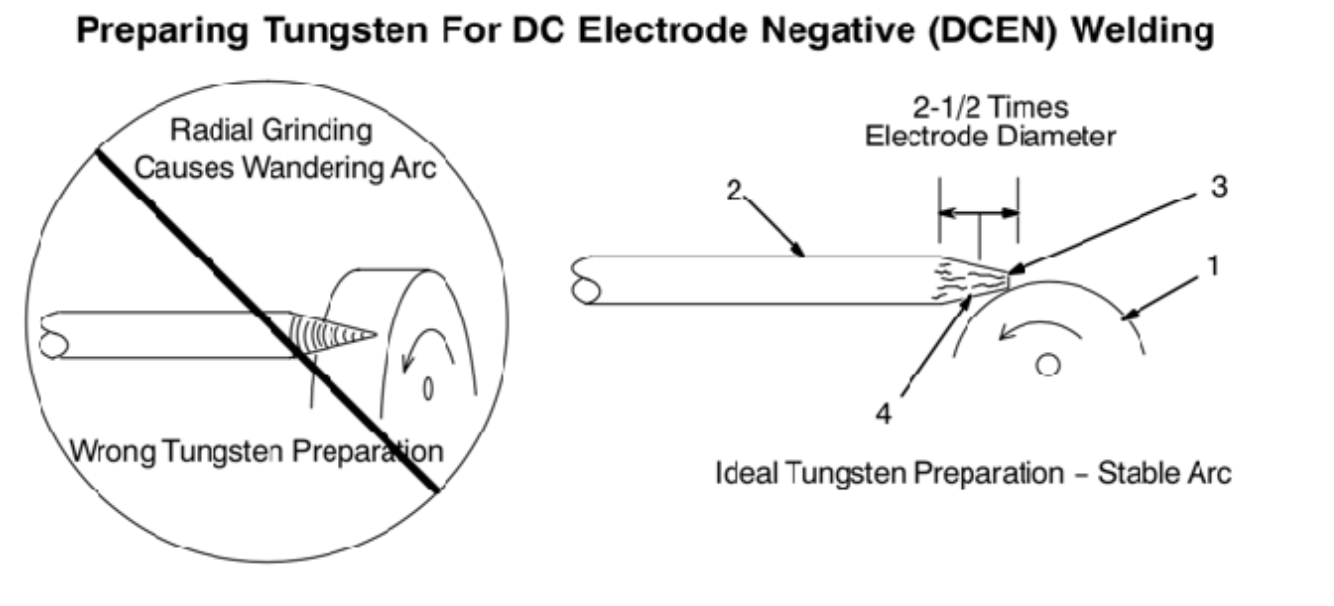
| |
|---|---|
| Incorrect and correct grinding of Tungsten electrodes. |
5. Return any unusual settings to for the next user. (Make sure on DC Neg., and “Pulse” turned off.)
6. Loosely Coil the torch cord and store on the work table’s torch hook.
7. Sharpen used Tungsten. Put away all tools and workplace accessories. Clean the work area.
1 - Use the shop’s dedicated pedestal grinder to sharpen / clean end of the tungsten electrode prior to welding.
2 - Grind longitudinally, not tangentially.
3 - Flat tip. Diameter of this flat determines amperage capacity.
Videos
Havoc caused by a broken cylinder valve
Mythbusters episode on gas cylinder rocketry
Welding Safety
Safety-wise, make sure your gloves (and, for that matter, all your skin and clothing) remain dry. This is a much bigger factor than glove leather thickness in mitigating electrical shock hazard.
(Shock hazard is less of a concern with MIG than with TIG or stick.)
Basics
- ALWAYS wear a proper face shield.
- ALWAYS wear close-toed shoes.
- ALWAYS wear a long-sleeved, non-flammable shirt.
- ALWAYS wear proper welding gloves.
- ALWAYS wear ear protection (earplugs or muffs) to prevent sparks from entering your ear canal. An eardrum punctured by a spark will instantly cauterize and never heal.
- NEVER weld on or near anything that's been cleaned with a chlorinated hydrocarbon like brake-cleaner. When combined with UV light, chlorinated hydrocarbons can create phosgene gas, which can cause serious injury or death. Ventilation will not prevent poisoning.
- If you burn yourself, immediately douse with cold water: seconds count!
Fire
Make sure the weld area is free from all flammable materials such as flammable liquids, paper, etc.
Do not wear clothing or gloves that have been exposed to flammable liquids.
Electrocution
Before turning on a welding machine, make sure there are no puddles of water on the floor around the weld bench or the machine. Make sure the weld machine is dry, including the main box, the torch, the pedal, and the plug.
There is little risk of fatal electrocution from a properly working TIG weld machine. When the user presses on the pedal to initiate the arc, a high-frequency low amplitude arc will emit from the tip of the weld torch. Once the machine detects the grounded metal piece that is to be welded, the arc will switch over to a high-amplitude DC current. Even if the operator deliberately points it toward their body, the shock will be mild, since the machine will not switch over to the high amplitude current.
Burns
Welded metal will remain hot for several minutes after it is welded. In most cases the heat is localized near the weld itself.
In the case of more conductive materials, such as copper and aluminum, the heat may be more distributed throughout the material.
In the case of TIG welding, sparks and spatter are non-existent, unless rusty or dirty metal is used. MIG welding steel will create sparks, so earplugs and full coverage safety glasses should be worn to prevent burns to sensitive tissue.
Gloves must be worn when welding and handling recently welded material. White cotton welding gloves may be used for light TIG welding, as long as they are free of holes. For heavier welding, deerskin or heavy duty welding gloves should be used.
UV Burns
The light emitted from a weld arc is brighter than that of the sun. Do not look at the arc without wearing a full-faced welding mask with a shade 10 or darker filter plate.
Always make sure the weld curtains are in place between the welder(s) and other people in the shop.
Be sure to cover any exposed skin, including cuff and collar areas, while welding or observing inside the weld area.
The rays from the arc can cause a UV burn much worse than a sunburn.
Observers may use a cardboard mask with a shade 10 filter plate.
Compressed Gas Cylinders
Argon and CO2 are inert, nontoxic gases normally present in the atmosphere. However, if allowed to fill an enclosed area these gases can fully displace breathable air, causing asphyxiation and death.
At the Asylum, the greater potential danger is the valve being knocked off the cylinder, turning it into a rocket powerful enough to severely injury or kill people and damage equipment and the building itself.
The following guidelines must be followed at all times:
Storing
- Cylinders must ALWAYS remain upright and NEVER be placed horizontally.
- Cylinders must be secured with a non-combustible material (metal) to an immovable object to prevented them from falling.
Moving
- Cylinders must be securely capped.
Pages in category "TIG Welders"
The following 4 pages are in this category, out of 4 total.
